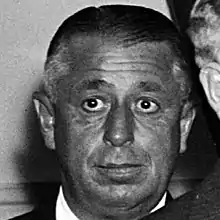Walter G. Andrews
Walter Gresham Andrews (July 16, 1889 – March 5, 1949) was an American politician and a Republican member of the United States House of Representatives from New York.
Walter Gresham Andrews | |
|---|---|
 | |
| Member of the U.S. House of Representatives from New York | |
| In office March 4, 1931 – January 3, 1949 | |
| Preceded by | S. Wallace Dempsey |
| Succeeded by | William L. Pfeiffer |
| Constituency | 40th district (1931–45) 42nd district (1945–49) |
| Personal details | |
| Born | July 16, 1889 Evanston, Illinois, U.S. |
| Died | March 5, 1949 (aged 59) Daytona Beach, Florida, U.S. |
| Citizenship | |
| Political party | Republican |
| Alma mater | Princeton University |
| Profession | Football coach
politician businessman |
| Awards | Distinguished Service Cross |
| Military service | |
| Allegiance | |
| Branch/service | |
| Rank | Private (1916)
Second Lieutenant (1917) Major (1917) |
| Unit | Troop I, First New York Cavalry (1916)
Machine Gun Group, First New York Cavalry (1917) 127th United States Infantry, 27th division (1917) |
| Battles/wars | World War I |
Biography
Andrews was born in Evanston, Illinois the son of William Henry and Kate (Gresham) Andrews; his grandfather and namesake was U.S. Secretary of State Walter Q. Gresham. He attended the public schools of Buffalo, New York, graduated from Lawrenceville School in 1908 and from Princeton Law School in 1913.[1]
Career
Andrews was head coach of the Princeton Tigers football team in 1913.
During World War I, he served on the Mexican border as a private, Troop I, First New York Cavalry, in 1916. Commissioned second lieutenant, he was with the Machine Gun Group, First New York Cavalry, in 1917. He served in France with the 107th Infantry Regiment, Twenty-seventh Division, and was promoted to major.[2] In 1918, he was wounded in an attack on the Hindenberg Line.[2] He was awarded the Distinguished Service Cross.[3][4]
After the war, Andrews was employed as superintendent and central sales manager, Pratt & Lambert, Inc., Buffalo, New York, until 1925.[2]
He was supervisor of the fifteenth federal census for the seventh district of New York in 1929 and 1930, and director of the Buffalo General Hospital.
Elected to Congress in 1930, Andrews served from March 4, 1931 until January 3, 1945 for the 40th District; and from January 3, 1945 to January 3, 1949 for the 42nd District.[5] He was chairman of the United States House Committee on Armed Services, during the 80th United States Congress. He was not a candidate for renomination, due to physicians advising him to take things easier.
Death
Andrews died in a hotel at Daytona Beach, Florida from a heart attack on March 5, 1949 (age 59 years, 232 days). He was cremated, and his ashes are interred at Old Fort Niagara Cemetery, Youngstown, New York.[6]
Head coaching record
| Year | Team | Overall | Conference | Standing | Bowl/playoffs | ||||
|---|---|---|---|---|---|---|---|---|---|
| Princeton Tigers (Independent) (1913) | |||||||||
| 1913 | Princeton | 5–2–1 | |||||||
| Princeton: | 5–2–1 | ||||||||
| Total: | 5–2–1 | ||||||||
References
- "Walter G. Andrews". Biographical Directory of the United States Congress. Retrieved 10 July 2013.
- Marquis Who's Who, Inc. Who Was Who in American History, the Military. Chicago: Marquis Who's Who, 1975. P. 13 ISBN 0837932017 OCLC 657162692
- "Walter G. Andrews". The Trustees of Princeton University. Retrieved 10 July 2013.
- "Valor awards for Walter Gresham Andrews".
- "Walter G. Andrews". Govtrack US Congress. Retrieved 10 July 2013.
- "Walter G. Andrews". The Political Graveyard. Retrieved 10 July 2013.
External links
- United States Congress. "Walter G. Andrews (id: A000250)". Biographical Directory of the United States Congress.
- Walter G. Andrews at Find a Grave
